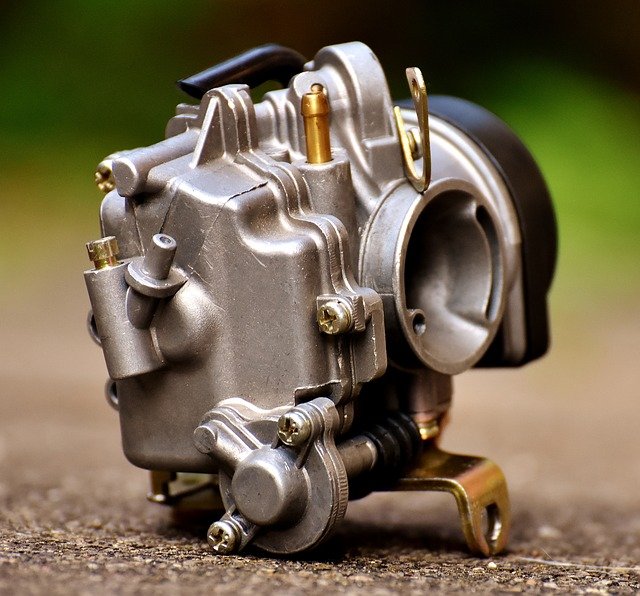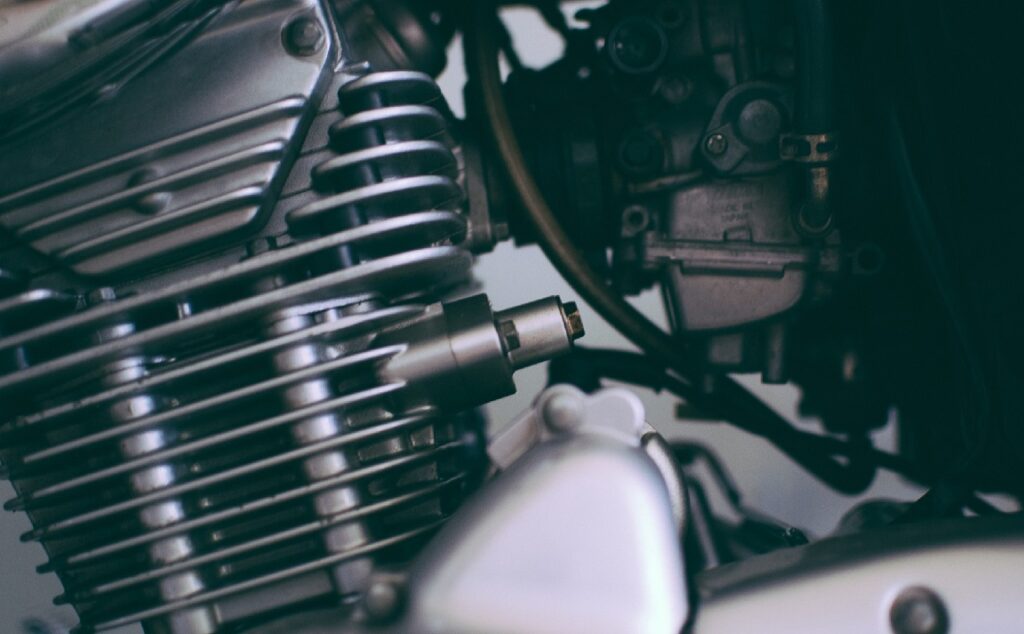Engine Overheating can be detrimental to your motorcycle’s health. The consequence of an overheated engine can be quite extreme ranging from low mileage and hard shifting to damaged cylinder lining.
So, what are the reasons for an overheated motorcycle engine?
The reasons for engine overheating include:
- Lean Air-Fuel Mixture
- Low Oil Level or Poor-Quality Engine Oil
- Low quality of Coolant constituents
- Leaks in Radiator
- Damaged Radiator Fan
- Damaged Thermostat
- Stressed Engine
Let us look at these causes one by one in detail.
#1 Lean Air-Fuel Mixture

In carburetted motorcycles, carburetor mixes and supplies the air-fuel mixture to the engine for combustion.
If the mixture setting in the carburetor is not right, then you will either have a rich air-fuel mixture or a lean air-fuel mixture.
Rich air-fuel mixture refers to more fuel supply in proportion to the air supplied. Lean mixture is the opposite. The air supply is higher than required for the amount of fuel supplied.
Now, when the air-fuel mixture is lean, there isn’t enough fuel in the engine to absorb the heat. Air has to carry all this heat resulted from the engine combustion and flow through the exhaust system.
If there is a continuous supply of lean air-fuel mixture, the excess heat in the air starts to build up overtime in the engine. As a result, the heat is absorbed by the engine components. Thus, the reason for engine overheating in your motorcycle.
Inappropriate air-fuel mixture is the main cause for engine overheating. So, whenever you face an overheating problem, check the carburetor first and fine tune it if it is the cause.
#2 Low Oil Level or Poor-Quality Engine Oil

Low oil level in your motorcycle is problematic and will lead to severe consequences in multiple components of the motorcycle.
Same goes to the use of poor-quality engine oil in your bike. The damages can vary from increased vibrations and hard shifting of gears to burnt clutch plates and damaged cylinder lining.
We usually leave the oil refilling part to the mechanic or the service center without even bothering to check the type of oil used.
If your motorcycle is using a mineral oil but you have a large capacity engine, it is a mismatch. Similarly, synthetic oil is not suitable for lower cc engines (cc is the engine capacity measured in cubic centimeters).
If you are going for a long ride and you know you will ride at high RPM most of the time, you need to replenish the oil levels with a quality one.
Poor quality or low levels of oil will not function as a good coolant that will carry away the heat. This is especially true in air-coolant systems where oil is super-important for carrying away the heat from the frictional surfaces.
Here is a detailed post on how to check the quality of engine oil. If you find the oil quality is poor, you must change the oil asap.
So, always use a good quality oil for your motorcycle. Don’t cheap out here. Also, frequently change your oil for certain distance traveled. As a general rule of thumb, here are the recommended frequency of oil change for the distance traveled based on the oil type you are using.
| Type of Oil | Frequency for Oil change |
|---|---|
| Mineral Oil | 2000 miles |
| Semi-Synthetic Oil | 5000 miles |
| Synthetic Oil | 8000 miles |
#3 Low Quality of Coolant Constituents

The function of a coolant system is to cool the engine and the exhaust system. If the coolant constituents are not right or their mixture is not optimal, we have a problem there.
Low quality constituents or wrong mixture proportions will not cool the engine and the exhaust sufficiently. The same goes when you interchangeably use car and motorcycle coolants.
Thereby causing the engine to overheat. A high-quality coolant is therefore a must in your motorcycle.
Additionally, using an effective coolant will improve the performance of the engine and hence the mileage of your motorcycle.
The most common constituent of coolants is ethylene glycol or propylene glycol. While ethylene glycol is widely used because of its low freezing point and cheap production cost, propylene glycol is much less-toxic.
You should typically change the coolant once every 2 years unless your bike’s user manual says otherwise. While changing the coolant, these are the characteristics you should look for in a coolant:
- Superior heat transfer with high boiling point
- Non-corrosive
- Low freezing point
- Non-toxic and non-irritating ingredients
- Compatible with the engine
- Biodegradable
- Pre-diluted for easy use
#4 Leaks in Radiator

Coolant removes the heat from the engine by carrying away the heat. Now you need the coolant to shed that heat as well right? To go back and cool the engine again. Well, radiator is the one that removes the heat from the coolant.
The engine cylinder will be dipped in the coolant. The heat generated is carried by the coolant which flows into the radiator. Radiator takes away the heat and cools down the coolant. Once cooled, coolant flows back and removes the heat again from the engine.
Now, if there are leaks in the radiator, the coolant levels will automatically go down. The coolant loss due to the leakage in radiator can prove costly as there is no sufficient coolant in the system. Lower levels of coolant will result in less heat taken away from the engine. As a result, the engine will start overheating.
So, check the radiator for any leakages in the coolant whenever your motorcycle engine overheats.
#5 Damaged Radiator Fan

Within the radiator, how do you think coolant gets cooled down? After all, there will be lots of heat accumulated in the coolant carried from the engine.
The radiator fan plays an important role in the cooling process of the coolant. The coolant flows between the radiator fins and the engine. Carrying the heat from one side and loosing it in the other. While flowing through the radiator fins, the radiator fan blows into the coolant to facilitate the cooling process.
However, imagine the fan is damaged. Then, the coolant coming from the radiator to the engine is not cooled down and still carries heat. The engine will provide more heat to the coolant. But the absorbing capacity of the coolant will reach its threshold and will not be able to take away the excess heat.
The heat will remain with the engine components. Thus, overheating the engine in the process. That’s why it is essential to look for any damages in the radiator fan since its functioning is important for the coolant to work properly.
#6 Damaged Thermostat

Thermostat is the component in Radiator that controls the radiator fan. Simply put, whenever the temperature of the engine rises above a limit, the sensors signal the thermostat to switch on the radiator fan. Similarly, thermostat switches off the fan when temperature decreases.
Basically, thermostat switches the fan on and off depending on the prevailing temperature in the engine and the coolant.
Now, if the thermostat gets damaged, your radiator fan is as good as dead too. It is like the lamp is working perfectly fine but the switch is damaged. So, lamp doesn’t work in the end.
This non-functioning of thermostat is one other cause to look out for when the engine overheats in your motorcycle.
#7 Stressed Engine

Another factor for engine overheating is when we stress the engine too much for an extended period of time.
This stressing can be in many forms. Riding the motorcycle at too high a RPM continuously in a long ride can be one cause. The engine is constantly revving up and pushing its limit. This high-speed revving is especially a concern in older motorcycles.
Other forms of stressing the engine include jammed disc brakes, jammed drum brakes, worn-out wheel bearings, insufficient grease in the wheels – all these inefficiencies hamper down the performance and puts enormous pressure on the engine. To achieve the same speed in these conditions as opposed to the normal one, the engine has to generate far more power continuously.
Even an overloading or a tight chain can put excess stress on the engine wherein the engine has to spew out more power to achieve normal speed in the motorcycle.
These above-mentioned factors inhibit the engine performance and requires the engine to produce far more power even for a minute change in speed. As a result, the motorcycle engine gets overheated due to this excess drain.
Solution and Preventive Measures
In order to prevent or solve the overheating issue, you need to take care of these causal areas.
To prevent lean air-fuel mixture entering into the engine, check the tuning of the carburetor. Also, if you have replaced the air filter make sure to check the exhaust as well.
For engine oil and coolant problems, change the oil and coolant regularly in your motorcycles. For oil change, the frequency depends on the distance traveled and the type of oil you are using. For mineral oil it is better to change every 2000 miles traveled and for synthetic oil, the mark is 8000 miles. For coolant, the thumb rule is to change every 2 years.
For radiator problems, like leakages, fan or thermostat damages, check for any signs of impairment in these components. While preventive maintenance can be tough here, it is better to check up on them once in a while.
For stressing out the engine occurrences, you need to take care of the root cause. Jammed brakes, low grease or oil, tight chain, overloading can all take a toll on your engine. You can clearly see it in the mileage performance of the engine whenever it is stressed due to one of these factors. So, address the issue at hand before it impacts your engine performance.
One caution to practice here is to never use water as a quick fix to cool down an overheated engine. Heated metal surfaces do not behave well when it comes in contact with water. Always allow the overheated engine to cool down naturally or blow air into it. But never water. Water and heated metal surface are not a great combination and you can potentially damage the functioning of engine parts.
With these solutions and preventive maintenance you are good to go and ride your motorcycle again without worrying about the engine overheating.
Having said that, what’s your favorite maintenance trick to keep the engine heating in check? Comment below.
